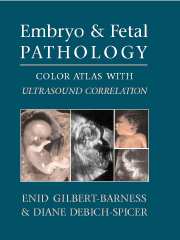Book contents
- Frontmatter
- Contents
- Foreword by John M. Opitz
- Preface
- Acknowledgments
- 1 The Human Embryo and Embryonic Growth Disorganization
- 2 Late Fetal Death, Stillbirth, and Neonatal Death
- 3 Fetal Autopsy
- 4 Ultrasound of Embryo and Fetus: General Principles
- 5 Abnormalities of Placenta
- 6 Chromosomal Abnormalities in the Embryo and Fetus
- 7 Terminology of Errors of Morphogenesis
- 8 Malformation Syndromes
- 9 Dysplasias
- 10 Disruptions and Amnion Rupture Sequence
- 11 Intrauterine Growth Retardation
- 12 Fetal Hydrops and Cystic Hygroma
- 13 Central Nervous System Defects
- 14 Craniofacial Defects
- 15 Skeletal Abnormalities
- 16 Cardiovascular System Defects
- 17 Respiratory System
- 18 Gastrointestinal Tract and Liver
- 19 Genito-Urinary System
- 20 Congenital Tumors
- 21 Fetal and Neonatal Skin Disorders
- 22 Intrauterine Infection
- 23 Multiple Gestations and Conjoined Twins
- 24 Metabolic Diseases
- Appendices
- Index
15 - Skeletal Abnormalities
Published online by Cambridge University Press: 23 February 2010
- Frontmatter
- Contents
- Foreword by John M. Opitz
- Preface
- Acknowledgments
- 1 The Human Embryo and Embryonic Growth Disorganization
- 2 Late Fetal Death, Stillbirth, and Neonatal Death
- 3 Fetal Autopsy
- 4 Ultrasound of Embryo and Fetus: General Principles
- 5 Abnormalities of Placenta
- 6 Chromosomal Abnormalities in the Embryo and Fetus
- 7 Terminology of Errors of Morphogenesis
- 8 Malformation Syndromes
- 9 Dysplasias
- 10 Disruptions and Amnion Rupture Sequence
- 11 Intrauterine Growth Retardation
- 12 Fetal Hydrops and Cystic Hygroma
- 13 Central Nervous System Defects
- 14 Craniofacial Defects
- 15 Skeletal Abnormalities
- 16 Cardiovascular System Defects
- 17 Respiratory System
- 18 Gastrointestinal Tract and Liver
- 19 Genito-Urinary System
- 20 Congenital Tumors
- 21 Fetal and Neonatal Skin Disorders
- 22 Intrauterine Infection
- 23 Multiple Gestations and Conjoined Twins
- 24 Metabolic Diseases
- Appendices
- Index
Summary
OSTEOCHONDRODYSPLASIAS
Bone is formed from collagen. Bone dysplasias predominantly involve one type of collagen (Figure 15.1). Terms used in the description of bone dysplasias according to the defect in collagen are shown in Table 15.1.
The normal growth plate or physis consists of four zones:
resting cartilage;
proliferative cartilage;
hypertrophic cartilage;
zone of provisional calcification.
The revised international classification of osteochondrodysplasias encompasses those disorders that are perinatally lethal and/or amenable to prenatal diagnosis (Table 15.2). Prenatal diagnosis has been made in most of the lethal forms of ostechondrodysplasia (Table 15.3). The osteochondrodysplasias include the infant or fetus with dwarfism. Most are lethal. For most convenience in diagnosis they can be divided into the following groups:
■ Osteochondrodysplasias with platyspondyly
■ Osteochondrodysplasias with short trunk
■ Short rib osteochondrodysplasias
■ Osteochondrodysplasias with defective bone density
■ Miscellaneous group
Osteochondrodysplasias with Platyspondyly (Table 15.4)
Although the trunk of the infants in this group is not significantly short, the vertebral bodies in the radiograph are markedly flattened. Histopathologically the physeal growth zones are usually disorganized and may be retarded, but the resting cartilage is mostly unremarkable.
- Type
- Chapter
- Information
- Embryo and Fetal PathologyColor Atlas with Ultrasound Correlation, pp. 388 - 427Publisher: Cambridge University PressPrint publication year: 2004

